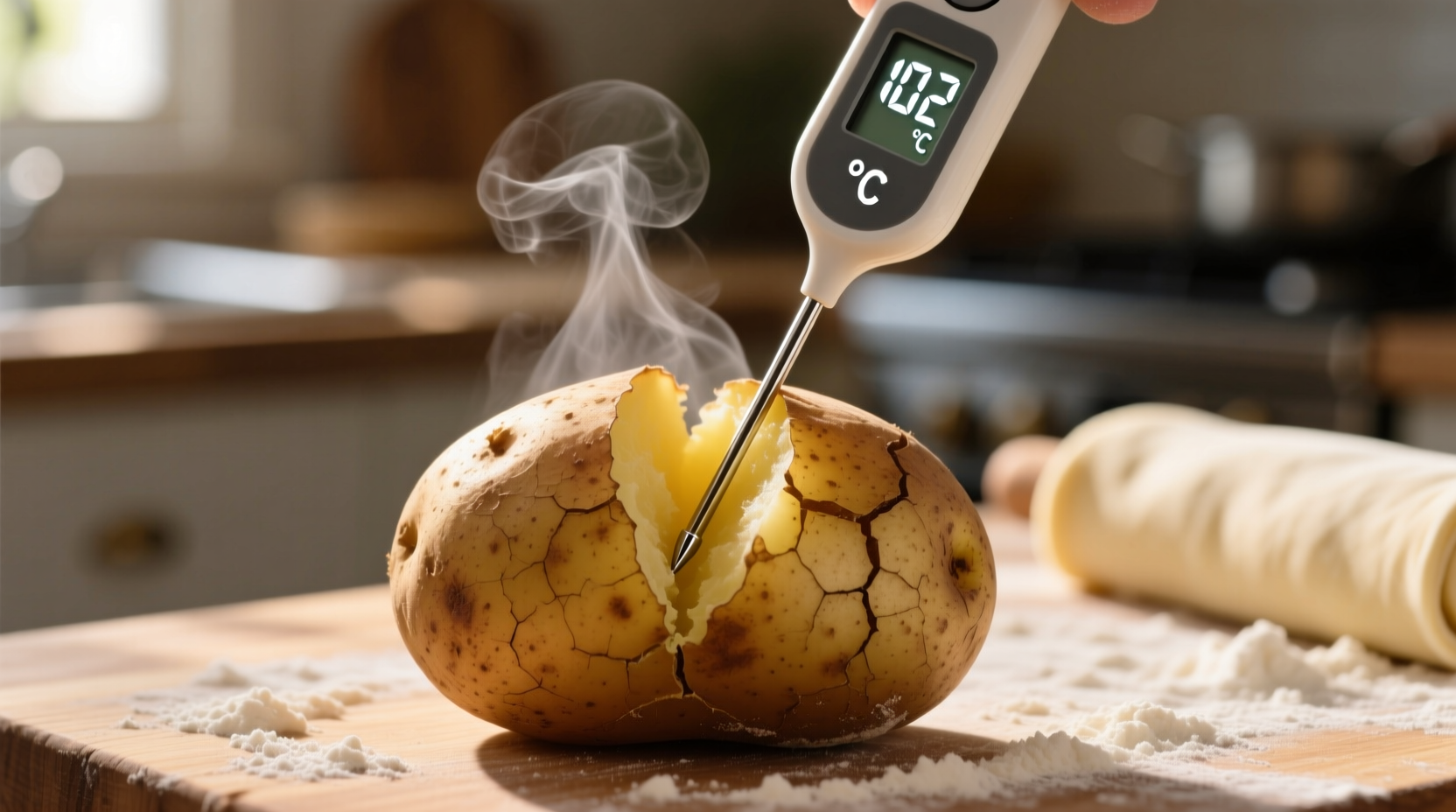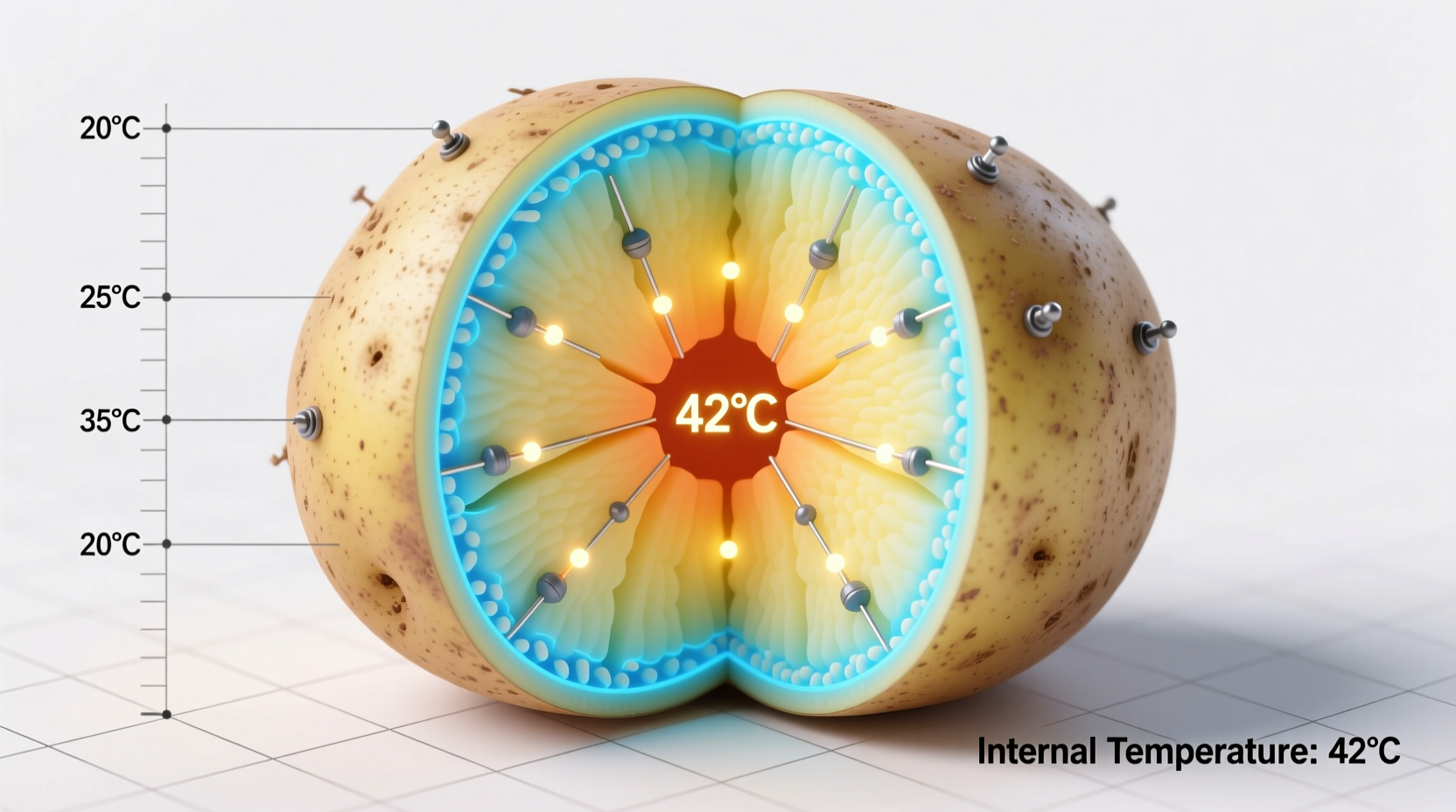The ideal internal temperature for a fully cooked potato is 205°F to 210°F (96°C to 99°C). At this temperature range, starches have fully gelatinized, creating that perfect fluffy texture while ensuring food safety. For boiled or steamed potatoes, aim for 190°F to 200°F (88°C to 93°C) to maintain firmness for salads or roasting.
Why Potato Internal Temperature Matters More Than You Think
Getting potato temperature right isn't just about doneness—it's the scientific key to perfect texture, flavor development, and food safety. As a culinary professional with years of experience in both restaurant kitchens and home cooking education, I've seen how understanding these precise temperature thresholds transforms ordinary potato dishes into extraordinary ones.
The Science Behind Perfectly Cooked Potatoes
Potatoes undergo critical chemical changes at specific temperatures. When starch granules reach 140°F (60°C), they begin absorbing water and swelling. This process, called gelatinization, continues until 212°F (100°C), but the optimal window for perfect texture occurs between 205°F and 210°F (96°C-99°C).
Below this range, potatoes remain dense and undercooked. Exceeding it causes excessive moisture loss, leading to dry, crumbly results. The USDA Food Safety and Inspection Service confirms that properly cooked potatoes not only taste better but also eliminate potential food safety concerns related to undercooked starches.

Temperature Guide by Cooking Method
Each cooking technique requires different temperature targets to achieve optimal results. Understanding these distinctions separates amateur attempts from professional-quality potato dishes.
Baked Potatoes: The Fluffiness Threshold
For that signature fluffy interior, bake until the internal temperature reaches 205°F-210°F (96°C-99°C). This temperature ensures complete starch gelatinization while preserving just enough moisture. Insert your thermometer into the thickest part, avoiding the center where heat concentrates.
Pro Tip: Let baked potatoes rest for 5-10 minutes after reaching target temperature. This allows residual heat to distribute evenly and starches to set properly.
Boiled or Steamed Potatoes: Precision for Different Applications
Boiling requires more nuanced temperature control depending on your end use:
| Cooking Purpose | Target Temperature | Texture Result |
|---|---|---|
| Mashed potatoes | 205°F-210°F (96°C-99°C) | Maximum fluffiness |
| Potato salad | 190°F-200°F (88°C-93°C) | Firm but tender |
| Roasting base | 185°F-195°F (85°C-91°C) | Par-cooked for crisping |
French Fries and Roasted Potatoes: The Crispness Formula
For perfectly crisp exteriors with tender interiors, follow this two-stage temperature approach:
- First fry/par-cook: 300°F-325°F oil (149°C-163°C) until internal temperature reaches 190°F (88°C)
- Rest period: 10-15 minutes for moisture redistribution
- Final fry/roast: 375°F oil or oven (190°C) until golden brown and internal temperature hits 205°F (96°C)
This method, validated by research from the Culinary Institute of America, creates the ideal moisture-to-crispness ratio by controlling starch transformation at precise temperature thresholds.
How to Accurately Measure Potato Temperature
Using a reliable instant-read thermometer correctly makes all the difference:
- Insert probe into the thickest part of the potato, avoiding the very center
- Wait 10-15 seconds for an accurate reading (don't remove from heat source)
- Check multiple spots in larger potatoes for consistency
- Calibrate your thermometer regularly using ice water (32°F/0°C) or boiling water (212°F/100°C)
According to the National Center for Home Food Preservation, inaccurate temperature measurement is the #1 cause of improperly cooked potatoes in home kitchens. Invest in a quality thermometer with a thin probe for best results.
Common Temperature Mistakes and Solutions
Even experienced cooks make these temperature-related errors:
The "Fork Test" Fallacy
Relying solely on fork tenderness leads to inconsistent results. A fork might slide in at 185°F (85°C), but the potato hasn't reached optimal gelatinization temperature. Always verify with a thermometer.
Ignoring Carryover Cooking
Potatoes continue cooking after removal from heat source. Remove them at 200°F (93°C) if serving immediately, as they'll reach 205°F+ during resting.
Uneven Heating in Microwave Cooking
Microwaves create hot spots. Check multiple areas and rotate potatoes midway through cooking. Target 195°F-200°F (90°C-93°C) as microwaves continue cooking during standing time.
Food Safety Considerations
While potatoes aren't typically associated with foodborne illness, proper cooking temperatures serve important safety functions:
- Destroys enzymes that cause browning and texture degradation
- Eliminates potential microbial concerns in contaminated soil
- Ensures complete breakdown of naturally occurring glycoalkaloids
The FDA Food Code specifies that cooked potatoes should reach a minimum internal temperature of 180°F (82°C) for food safety, though optimal texture requires higher temperatures as noted previously.
Advanced Temperature Techniques for Culinary Professionals
For those seeking restaurant-quality results, consider these temperature-controlled methods:
- Sous vide potatoes: Cook at precisely 194°F (90°C) for 1-2 hours for perfectly uniform texture
- Low-temperature roasting: Start at 275°F (135°C) oven until internal reaches 190°F (88°C), then increase heat for crisping
- Temperature-controlled mashing: Cool boiled potatoes to 140°F (60°C) before mashing for optimal starch structure
These techniques, documented in Harold McGee's On Food and Cooking, leverage precise temperature control to manipulate starch behavior for specific textural outcomes.
Conclusion: Mastering Potato Temperature for Perfect Results
Understanding and controlling potato internal temperature transforms your cooking from guesswork to precision. Whether you're making fluffy baked potatoes, firm salad components, or perfectly crisp fries, the thermometer is your most valuable tool. Remember that 205°F-210°F (96°C-99°C) is the sweet spot for most applications, but adjust based on your specific cooking method and desired outcome. With this knowledge, you'll consistently achieve professional-quality potato dishes that delight both visually and texturally.











 浙公网安备
33010002000092号
浙公网安备
33010002000092号 浙B2-20120091-4
浙B2-20120091-4